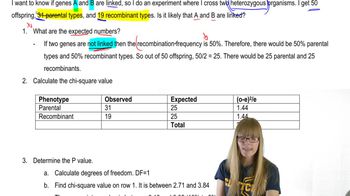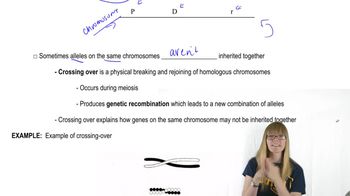Table of contents
- 1. Introduction to Genetics51m
- 2. Mendel's Laws of Inheritance3h 37m
- 3. Extensions to Mendelian Inheritance2h 41m
- 4. Genetic Mapping and Linkage2h 28m
- 5. Genetics of Bacteria and Viruses1h 21m
- 6. Chromosomal Variation1h 48m
- 7. DNA and Chromosome Structure56m
- 8. DNA Replication1h 10m
- 9. Mitosis and Meiosis1h 34m
- 10. Transcription1h 0m
- 11. Translation58m
- 12. Gene Regulation in Prokaryotes1h 19m
- 13. Gene Regulation in Eukaryotes44m
- 14. Genetic Control of Development44m
- 15. Genomes and Genomics1h 50m
- 16. Transposable Elements47m
- 17. Mutation, Repair, and Recombination1h 6m
- 18. Molecular Genetic Tools19m
- 19. Cancer Genetics29m
- 20. Quantitative Genetics1h 26m
- 21. Population Genetics50m
- 22. Evolutionary Genetics29m
4. Genetic Mapping and Linkage
Mapping Overview
Problem 1d
Textbook Question
In this chapter, we focused on linkage, chromosomal mapping, and many associated phenomena. In the process, we found many opportunities to consider the methods and reasoning by which much of this information was acquired. From the explanations given in the chapter, what answers would you propose to the following fundamental questions? How do we know that specific genes are linked on a single chromosome, in contrast to being located on separate chromosomes?
 Verified step by step guidance
Verified step by step guidance1
Understand the concept of genetic linkage: Genes that are located close to each other on the same chromosome tend to be inherited together, which is known as genetic linkage.
Consider the results of dihybrid or multihybrid crosses: If genes are linked, the offspring will show a higher frequency of parental-type combinations of traits than would be expected if the genes assorted independently.
Analyze recombination frequency: Calculate the recombination frequency between two genes. A recombination frequency of less than 50% suggests that the genes are linked and located on the same chromosome.
Use genetic mapping techniques: Construct a genetic map using recombination frequencies to determine the relative positions of genes on a chromosome. Genes that are closer together will have lower recombination frequencies.
Examine experimental evidence: Review experimental data from studies such as those involving test crosses or backcrosses, which can provide evidence of linkage through observed phenotypic ratios that deviate from expected Mendelian ratios.
Recommended similar problem, with video answer:
 Verified Solution
Verified SolutionThis video solution was recommended by our tutors as helpful for the problem above
Video duration:
2mPlay a video:
Was this helpful?
Key Concepts
Here are the essential concepts you must grasp in order to answer the question correctly.
Genetic Linkage
Genetic linkage refers to the tendency of genes located close to each other on the same chromosome to be inherited together during meiosis. This occurs because the physical proximity of genes reduces the likelihood of recombination events separating them. Understanding linkage is crucial for determining the inheritance patterns of traits and for constructing genetic maps.
Recommended video:
Guided course

Chi Square and Linkage
Recombination Frequency
Recombination frequency is a measure of how often two genes on the same chromosome are separated during meiosis due to crossing over. It is calculated as the percentage of recombinant offspring produced in a genetic cross. A low recombination frequency indicates that genes are closely linked, while a higher frequency suggests they are further apart or on different chromosomes.
Recommended video:
Guided course

Recombination after Single Strand Breaks
Chromosomal Mapping
Chromosomal mapping is the process of determining the relative positions of genes on a chromosome. This is achieved through techniques such as linkage analysis, which uses recombination frequencies to estimate distances between genes. Accurate chromosomal mapping is essential for understanding gene function, inheritance patterns, and the genetic basis of diseases.
Recommended video:
Guided course

Mapping with Markers

 11:11m
11:11mWatch next
Master Mapping Overview with a bite sized video explanation from Kylia Goodner
Start learningRelated Videos
Related Practice


